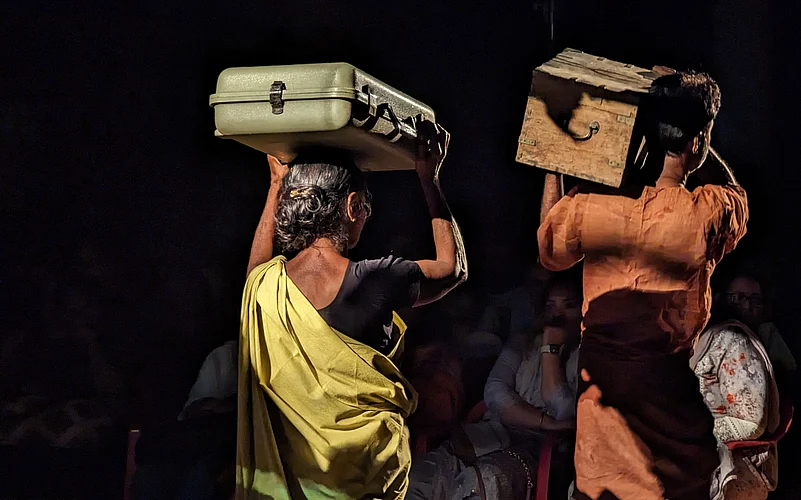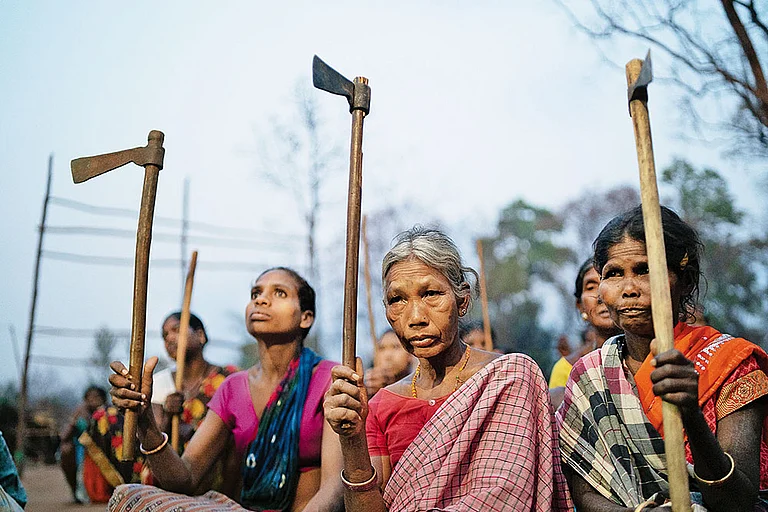Latha Dileep, 46, a daily-wage labourer working under the Mahatma Gandhi National Rural Employment Guarantee Act (MGNREGA) programme, never imagined she would become a theatre actor. In fact, she was not interested in acting at all. For the past 36 years, her life has been a relentless and exhausting battle against tidal floods, just as it is for the residents of Puthenvelikkara Panchayat, an island in the backwaters of Kochi’s coastal belt. Anything more than mere survival amid the daily flooding is a luxury. Latha, one of the performers in the drama Chevittorma, still refuses to acknowledge that she acted. “I did not act, none of us did. It was our life. We were sharing our harrowing life experiences with the audience,” she says.
Whispering Hope: The Real-Life Stories Behind Chevittorma
A unique play about the plight of people afflicted by tidal floods in coastal Kerala is a grim reminder of climate change

Chevittorma (A memoir of the moribund) poignantly captures the life of people battling tidal floods, a phenomenon that has been exacerbating for more than a decade in the coastal villages of central Kerala, impacted by climate change. The stage is a square-shaped platform that has been transformed into a makeshift pool with shallow, brackish water lapping gently at its edges. Actors, barefoot and dressed in weathered clothing, move gracefully through the water; their steps creating ripples that symbolise the ever-present threat of the tide. The lighting shifts subtly, reflecting the transition between day and night, casting shadows and highlighting the reflective surface of water. As the actors move with their clothes wet up to their knees, the subtle sound of the water waves combined with the deep, melodious music gives the audience an eerie sense of being trapped in water where there is no escape. As the drama unfolds, the audience witnesses the unfiltered realities of a community severely impacted by climate change, striving to aspire for hope despite living in utter despair.
This sensation mirrors the daily reality of people in these coastal villages besieged by tidal floods. The stage, with its makeshift pool, becomes a powerful symbol of resilience and loss, echoing the voices of those who continue to endure the suffering despite the odds. The actors do not render scripted dialogue; instead, they speak of their own lives, sharing their personal stories and memories.
“I came to this village 36 years ago. It was a village of abundant green beauty. All that has changed. The tidal floods slowly swallowed the village; the crops—banana, coconut and vegetables—were destroyed by saline water. When a boy in my neighbourhood died, we did not have a piece of dry land to cremate him. We were not even able to go and see the body as their tiny shack was inundated by tidal waves. We live in deep grief, and we need liberation from this sorrow,” says Latha.
As the light slowly brightens the stage, Latha sits on a chair in the middle of the water delivering a heart-wrenching monologue. She is not just recounting the harrowing experience of living in a flooded home on stage; she is narrating her own circumstances of life.
But what she did not deliver as dialogue on stage, she shared with Outlook: “A few years ago, my father passed away. We did not know what to do with his mortal remains as our land was inundated with tidal waters. Our custom is to cremate the dead, not bury, but there was no dry place to make a pyre. The villagers then made an elevated platform and cremated him.”
She recollects that while delivering dialogues on stage, she was burning with the painful, unhealing memory of her father’s demise. And every time the play is performed, Latha cries.
Chevittorma, the community theatre performance, is one of the flood-resilient initiatives envisaged by a group of scholars, environmentalists and artists. The community-driven tidal flood mitigation programme―implemented by EQUINOCT, a non-profit organisation advocating climate change issues, along with the Tata Institute of Social Sciences (TISS), and local self-governments of the affected villages―includes tidal monitoring and flood mapping by the community; creating climate action plans and campaigns; training video volunteers; and, developing community theatre. The project is being implemented in the three worst-hit panchayats―Kumbalangi, Puthenvelikkara, and Ezhikkara―which are low-lying islands in the coastal belt of Ernakulam district.
Tidal flooding occurs when the sea level rises above a certain threshold and enters inland through river mouths, spreading according to the elevation and topography of the coastal landscape. Previously considered a temporary phenomenon, caused by a combination of sea storms and lunar cycles, tidal flooding is now globally recognised as one of the first tangible impacts of sea level rise.
According to K G Sreeja, Jayaraman Chillayil and T G Madusoodhanan, the scholars who anchor the community resilient programme, the people in these flood hit panchayats should be considered as climate change refugees.
According to these experts, tidal floods have become a long-term reality in the coastal-estuarine landscape of Kerala, coinciding with full and new moons and the peak spring tide season, during November-December. “Regular and increased inundation with saline water for most parts of the year in these localities cause lasting damages to homes and other infrastructure. Unlike sea surges and direct erosion of the coastline, the impacts of tidal flooding are chronic, corrosive and long-term. Abandoning their hard-earned properties and other physical assets that were meticulously built over a lifetime, these people are the first of the climate refugees in our state. But there is no official record of this silent impact of climate change related migration that is happening all along our coastline and no administrative mechanism to redress the losses suffered,” states an article written by the scholars.
During every phase of natural calamities, women endure multiple displacements. All the female actors in this production―mirroring the experiences of many women in these flood-ravaged villages―did not grow up there. They settled in these villages after marriage.
“I have been here for 32 years. My native village is Chendamangalam, a village located a few kilometres from the West Coast. Though our village is also an island, we never faced tidal flooding. All my hardships began after I moved here after marriage,” says Shailaja.
Latha too was born and raised in a neighbouring village and had never encountered the challenges of flooding before. “In those days, women had no say in decisions related to marriage. We didn’t inquire whether the groom’s village was prone to natural disasters or had access to clean drinking water. Times have changed. Now, girls have a voice, and they refuse to marry residents from such villages,” says Latha.
“I was assigned by a team of environmental scholars to direct this play,” says Sreejith Ramanan, reflecting on Chevittorma. “In January 2022, we visited the villages. Our video team delved deep into the folklore, local practices, art forms and music, along with the devastating impact of climate change on their lives,” recalls Sreejith. Organising people unfamiliar with theatre and acting proved to be challenging. “There was no written script. The script emerged collectively, from their lived experiences—grief, loss, fear and uncertainty,” says Sreejith. "Our preconceived notions of theatrical aesthetics crumbled as we confronted the heart-wrenching realities of these people's everyday lives, who are the casualties of climate change,” says Sreejith.
All actors, except one who is a policeman working at a local police station, are daily-wage workers and fishermen from the village. For them, participating in this theatre production has been an incredible journey, beyond anything they could have imagined. “A friend told me about the theatre workshop, and I decided to join. My mother-in-law didn’t approve of me acting and staying out late for rehearsals, but my husband is very supportive,” says Shailaja, who also works under MGNREGA. All women are active participants of Kudumbashree, Kerala’s pioneering poverty eradication and women empowerment programme.
For Shailaja, Chevittorma is more than just a play. “We have been dealing with tidal floods for over a decade, but nobody paid attention to our struggle. But after we performed this play in Delhi and Mumbai, the world started to take note of our hardships,” says Shailaja.
The name of the play, Chevittorma, was suggested by the team members. Chevittorma refers to a local custom of whispering prayers into the ears of a dying person who is too weak to chant it by herself. The play is conceived as a prayer for a dying community—a poignant attempt to provide solace and draw society’s attention to their arduous struggle. “This play serves both as a plea for acknowledging the unsustainable living conditions exacerbated by global warming, as well as a showcase to present a local initiative amid a global crisis and using theatre as a medium,” explains Sreejith, articulating the vision of the actors and artists behind the production.
- Previous Story
 Elections 2024: Ashok Tanwar Joins Congress Again; Sehwag Endorses Congress Candidate In Haryana
Elections 2024: Ashok Tanwar Joins Congress Again; Sehwag Endorses Congress Candidate In Haryana - Next Story


























